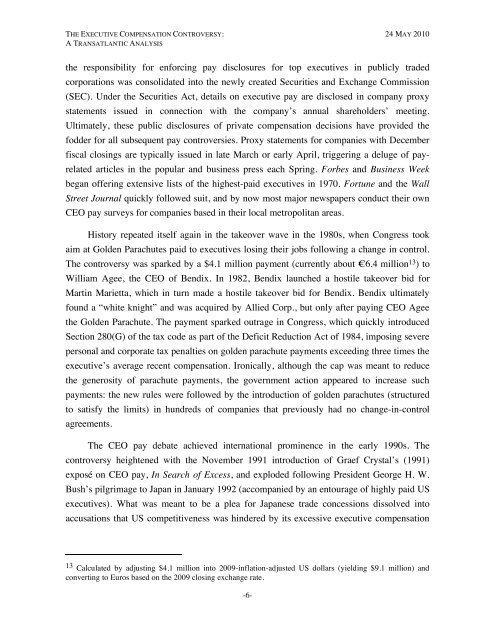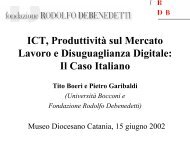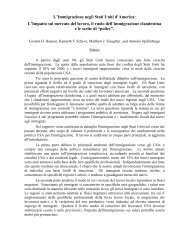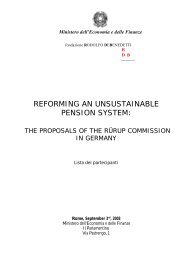The Executive Compensation Controversy - Fondazione Rodolfo ...
The Executive Compensation Controversy - Fondazione Rodolfo ...
The Executive Compensation Controversy - Fondazione Rodolfo ...
You also want an ePaper? Increase the reach of your titles
YUMPU automatically turns print PDFs into web optimized ePapers that Google loves.
THE EXECUTIVE COMPENSATION CONTROVERSY: 24 MAY 2010A TRANSATLANTIC ANALYSISthe responsibility for enforcing pay disclosures for top executives in publicly tradedcorporations was consolidated into the newly created Securities and Exchange Commission(SEC). Under the Securities Act, details on executive pay are disclosed in company proxystatements issued in connection with the company’s annual shareholders’ meeting.Ultimately, these public disclosures of private compensation decisions have provided thefodder for all subsequent pay controversies. Proxy statements for companies with Decemberfiscal closings are typically issued in late March or early April, triggering a deluge of payrelatedarticles in the popular and business press each Spring. Forbes and Business Weekbegan offering extensive lists of the highest-paid executives in 1970. Fortune and the WallStreet Journal quickly followed suit, and by now most major newspapers conduct their ownCEO pay surveys for companies based in their local metropolitan areas.History repeated itself again in the takeover wave in the 1980s, when Congress tookaim at Golden Parachutes paid to executives losing their jobs following a change in control.<strong>The</strong> controversy was sparked by a $4.1 million payment (currently about €6.4 million 13 ) toWilliam Agee, the CEO of Bendix. In 1982, Bendix launched a hostile takeover bid forMartin Marietta, which in turn made a hostile takeover bid for Bendix. Bendix ultimatelyfound a “white knight” and was acquired by Allied Corp., but only after paying CEO Ageethe Golden Parachute. <strong>The</strong> payment sparked outrage in Congress, which quickly introducedSection 280(G) of the tax code as part of the Deficit Reduction Act of 1984, imposing severepersonal and corporate tax penalties on golden parachute payments exceeding three times theexecutive’s average recent compensation. Ironically, although the cap was meant to reducethe generosity of parachute payments, the government action appeared to increase suchpayments: the new rules were followed by the introduction of golden parachutes (structuredto satisfy the limits) in hundreds of companies that previously had no change-in-controlagreements.<strong>The</strong> CEO pay debate achieved international prominence in the early 1990s. <strong>The</strong>controversy heightened with the November 1991 introduction of Graef Crystal’s (1991)exposé on CEO pay, In Search of Excess, and exploded following President George H. W.Bush’s pilgrimage to Japan in January 1992 (accompanied by an entourage of highly paid USexecutives). What was meant to be a plea for Japanese trade concessions dissolved intoaccusations that US competitiveness was hindered by its excessive executive compensation13 Calculated by adjusting $4.1 million into 2009-inflation-adjusted US dollars (yielding $9.1 million) andconverting to Euros based on the 2009 closing exchange rate.-6-









